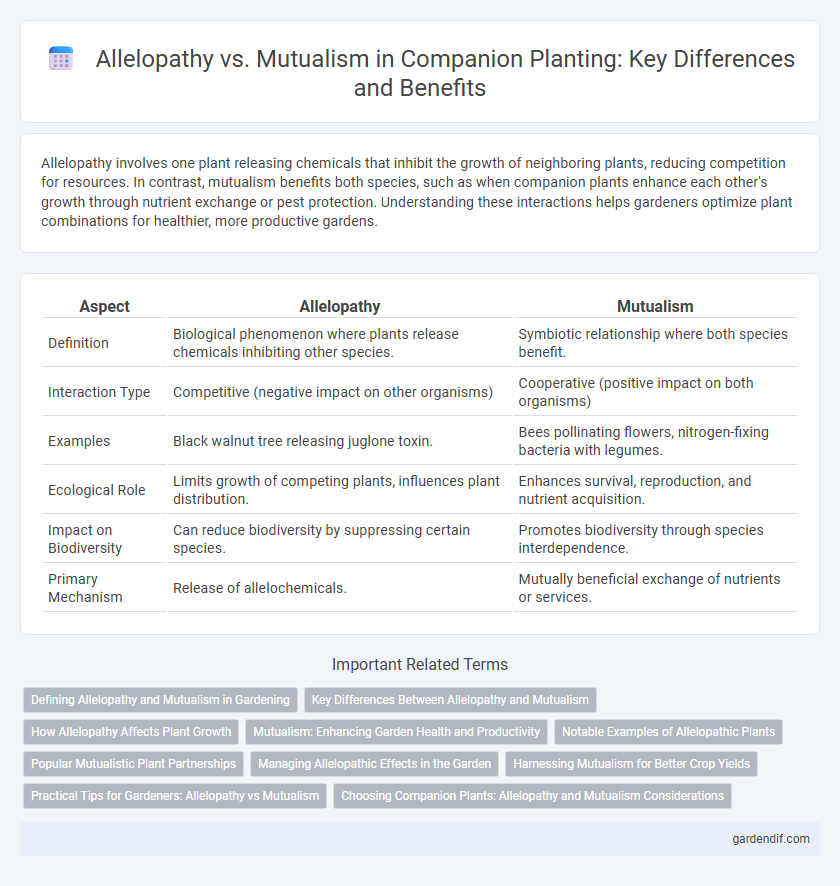
Allelopathy vs mutualism Illustration
Allelopathy involves one plant releasing chemicals that inhibit the growth of neighboring plants, reducing competition for resources. In contrast, mutualism benefits both species, such as when companion plants enhance each other's growth through nutrient exchange or pest protection. Understanding these interactions helps gardeners optimize plant combinations for healthier, more productive gardens.
Table of Comparison
| Aspect | Allelopathy | Mutualism |
|---|---|---|
| Definition | Biological phenomenon where plants release chemicals inhibiting other species. | Symbiotic relationship where both species benefit. |
| Interaction Type | Competitive (negative impact on other organisms) | Cooperative (positive impact on both organisms) |
| Examples | Black walnut tree releasing juglone toxin. | Bees pollinating flowers, nitrogen-fixing bacteria with legumes. |
| Ecological Role | Limits growth of competing plants, influences plant distribution. | Enhances survival, reproduction, and nutrient acquisition. |
| Impact on Biodiversity | Can reduce biodiversity by suppressing certain species. | Promotes biodiversity through species interdependence. |
| Primary Mechanism | Release of allelochemicals. | Mutually beneficial exchange of nutrients or services. |
Defining Allelopathy and Mutualism in Gardening
Allelopathy in gardening refers to the biological phenomenon where certain plants release chemicals that inhibit the growth of nearby competing plants, thus affecting plant interactions and crop yields. Mutualism involves a symbiotic relationship where both plant species benefit, such as legumes enriching soil nitrogen for companion plants. Understanding these interactions enables gardeners to optimize plant placement and improve garden health through natural chemical and cooperative processes.
Key Differences Between Allelopathy and Mutualism
Allelopathy involves one organism releasing chemicals that inhibit the growth or survival of another, whereas mutualism benefits both species through cooperative interactions. In allelopathy, the relationship is antagonistic and often competitive, while mutualism features reciprocal advantages enhancing survival and reproduction. Key distinctions include chemical inhibition in allelopathy versus resource or service exchange in mutualism, shaping different ecological dynamics.
How Allelopathy Affects Plant Growth
Allelopathy influences plant growth by releasing biochemical compounds from roots, leaves, or stems that inhibit the germination and development of neighboring plants. These allelochemicals create a competitive environment, reducing biodiversity and limiting resource availability for sensitive species. Understanding allelopathy is crucial for managing plant interactions and improving crop yield in companion planting systems.
Mutualism: Enhancing Garden Health and Productivity
Mutualism in companion planting involves interactions where both plant species benefit, leading to improved nutrient uptake, pest resistance, and overall garden health. For example, legumes fix nitrogen, enriching soil fertility for neighboring plants, while certain flowering plants attract pollinators that increase crop yields. This symbiotic relationship enhances garden productivity by fostering a balanced ecosystem that supports plant growth and resilience.
Notable Examples of Allelopathic Plants
Notable examples of allelopathic plants include black walnut (Juglans nigra), which releases juglone, a compound toxic to many surrounding plants, inhibiting their growth. Eucalyptus species produce allelochemicals that suppress understory vegetation, reducing competition for nutrients and water. Sorghum also emits sorgoleone, an allelopathic agent that affects weed seed germination and root elongation, demonstrating natural weed control mechanisms.
Popular Mutualistic Plant Partnerships
Mutualistic plant partnerships, such as the relationship between legumes and Rhizobium bacteria, enhance nitrogen fixation, promoting soil fertility and plant growth. Mycorrhizal fungi form symbiotic associations with plant roots, improving water and nutrient uptake while receiving carbohydrates in return. These popular mutualisms support sustainable agriculture by increasing crop yields and reducing the need for synthetic fertilizers.
Managing Allelopathic Effects in the Garden
Managing allelopathic effects in the garden involves selecting companion plants that can tolerate or neutralize inhibitory chemicals released by allelopathic species like black walnut or eucalyptus. Incorporating plants such as clover, vetch, or certain grasses helps improve soil health and counteract allelochemicals, promoting mutualistic interactions that enhance growth and nutrient uptake. Regular soil testing and organic matter addition optimize the garden environment, reducing allelopathy's negative impact and fostering a balanced plant community.
Harnessing Mutualism for Better Crop Yields
Harnessing mutualism in agriculture enhances crop yields through beneficial plant relationships that promote nutrient exchange and pest resistance. Unlike allelopathy, which involves chemical inhibition among plants, mutualism fosters symbiotic partnerships with microorganisms such as mycorrhizal fungi and nitrogen-fixing bacteria, improving soil fertility and plant health. Integrating mutualistic companions into crop systems supports sustainable practices by reducing reliance on synthetic fertilizers and pesticides.
Practical Tips for Gardeners: Allelopathy vs Mutualism
Understanding allelopathy and mutualism helps gardeners optimize plant selection and placement for healthier growth. To mitigate allelopathic effects, avoid planting species like black walnut near sensitive plants and use mulch to reduce chemical buildup. Encourage mutualism by introducing mycorrhizal fungi and planting nitrogen-fixing legumes to boost soil fertility naturally.
Choosing Companion Plants: Allelopathy and Mutualism Considerations
Choosing companion plants requires understanding allelopathy, where certain species release chemicals inhibiting neighboring plant growth, and mutualism, which involves beneficial interactions enhancing nutrient uptake and pest resistance. Selecting plants with complementary allelopathic traits can suppress weeds naturally, while mutualistic pairs improve soil fertility and increase crop yield through shared resources and protection. Considering both allelopathy and mutualism ensures optimized plant health and sustainable garden ecosystems.
Allelopathy vs mutualism Infographic

 gardendif.com
gardendif.com